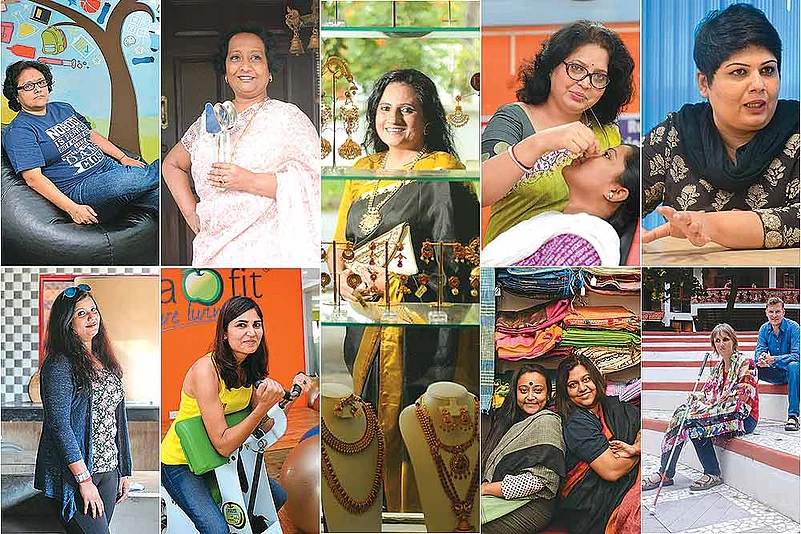We bring stories of women stepping up to the plate when most needed by their families. Life crises such as death of a loved one, illness in the family (or their own) or divorce are pushing women to find creative solutions. Who is to say these women are lesser entrepreneurs than those who came armed with MBAs and/or inherited wealth? Still, who thinks of the ‘local parlour lady’ or the neighbourhood boutique owner as entrepreneurs? Does an entrepreneur lurk beneath every persistent Tupperware lady or the talkative masseuse who comes home on Sundays? Yet, what but ‘social visionary’ can define, say, a 46-year-old who lost her eyesight in childhood and then starts an offbeat educational venture? Who knows what these women think of themselves? There’s a common strand, though, in the aspirational arc. The parlour lady has no time to scrub floors at home, and the boutique aunty has a new car. They all want to be reborn in the outside world—a world they know exists. The job world may be shrinking out there, but women are in business.

Rio Learning & Technologies, New Delhi
It was never Arti Pandey’s dream to become an entrepreneur. She had been working 12-14-hour workdays for a major academic publisher, but felt no closer to getting the recognition and remuneration she sought. The employers were also not keen to let her pursue her area of interest—writings textbooks for younger readers. The thought of going solo struck her first in 2011. Coincidentally, her marriage was also nearing an end then. No longer did she want to be part of anything she didn’t feel passionate about. Come 2015, when she completed eight years in the job, she quit.
“I always had an independent streak,” she says. “For eight years, I wrote content for higher education. And I wanted to create content for children.” As her employers were reluctant to expand into that territory, she realised she just had to start her own outfit. Today she manages 50 employees at her publishing outfit, Rio Learning & Technologies.
Arti and her team are doing well, but it is still a daily struggle. “Nobody funds you while you struggle, more so if you are a woman,” she says. “When women seek housing loans, they need guarantors—male buyers do not.” Arti still meets people who dismiss her as a failure. Hailing from a “very, very” middle-class family, she met opposition only from outside—from those who saw her strivings as mere enjoyable diversion. “Especially in north India, women in business are either born to entrepreneurs or married to rich men. Only now do more people feel I must be doing something worthwhile—my employees get paid, after all,” she chuckles.
At Rio, Arti steadfastly maintains her own style of working and the partners keep independent timings as well—luxuries a job normally does not offer. They write textbooks and create technology solutions for schools, known as Enterprise Resource Planning. Dissatisfaction with how educational content gets written in India was indeed another driving factor behind Arti’s decision to become a businesswoman. Textbooks in India, she complains, are not revised often enough.
All her effort, concentration and energy—the three things Arti considers her assets—go entirely into her venture. “There is no Plan B.” she says. Children’s books offer scope for creativity, in a way textbooks for older students and higher education do not. “Young readers are also more sensitive. You must be unbiased when writing for them. You cannot quote incorrectly from history. You cannot expose children to false perceptions, such as of beauty,” she says. “Regional biases and factual inaccuracies can impair entire generations.”

Shubhangi Banquets, Noida
It’s a different story for 27-year-old Reena Verma from Uttar Pradesh, whose father passed away in 2014, making her the sole breadwinner for her mother, two brothers and an elder sister. In 2012, she had been through a bout of depression, when she didn’t step out of her home for two months. “I wished I were dead,” she says. “But I have to arrange for my elder sister’s wedding, educate my brothers and ensure my mother has more than a small pension to get by.” She did some odd jobs in Noida until settling into a liaison officer’s job with the Noida Authority. But she always knew she wanted to start her own business.
It was entirely by chance that she met Sukumar Mukherjee at a birthday party. She sought a discount at his venue for her own birthday party, which turned out to coincide with that of Sukumar’s mother. A friendship began and Reena told him: “Let’s do business together.” Now they run Shubhangi, a chain of banquets, as business partners, organising catering, wedding planning and corporate parties. Reena brings in investors and big-shot wedding contracts—the latest is a South Africa-based Indian-origin businessman who has promised funds for building a three-star hotel in Noida. They have already identified the land.

VivaFit fitness centres, Gurgaon
Every time Manisha Ahlawat walks into her parents’ bustling home in western UP’s Meerut city, a strange silence descends upon it. “I speak out, stand with equal treatment for women and don’t acquiesce to discrimination. Hence, my family often retreats into silence around me,” says the 43-year-old, whose two children have grown up and don’t live with her. The family doesn’t know how to cope with her, the only independent businesswoman in an affluent, tradition-bound clan—one that let her learn to drive, but also married her off at 19 as the parents were afraid she might elope.
“It’s tough being a woman entrepreneur,” says Manisha, who lives in Gurgaon and runs the women-only VivaFit chain of fitness centres. “The biggest fight is with the family. In the US, where I lived until my divorce more than a decade ago, there is discrimination at the workplace and domestic violence, but families don’t discriminate between sons and daughters. In India, it’s the opposite.” She had to face opposition from her family when she bid for the north Indian franchise of the Portuguese fitness brand.
After returning from the US, she did a couple of jobs before making the big leap—start her own business. It was tough. She pawned her jewellery, borrowed from friends and did whatever else it took to keep going. “We can fight it out in the world if the family supports us. If they don’t, it gets harder,” she says.
After a hasty, unprofitable expansion, or when relocating the centres was her only way to stay afloat, her clan’s discouraging voices played in her head: “Come back. Forget about being a businesswoman.” Those were words she had been told repeatedly—all her kin except a sister and her spouse had discouraged her. The words would come back at difficult moments, nudging her to give up. “To go home would be to admit defeat,” Manisha says.
As someone once said: “Behind the glory and guts of women in business lies a family constantly telling her, ‘You can’t do it. Give up now.’” That’s how it turned out in Manisha’s case at least. Her business has been doing well since a restructuring in 2015 and expansions plans are on the anvil again. Hoping to be more careful this time, she says, “I work only for an identity of my own, separate from my father and brother’s.”

Beauty parlour, Calcutta
Tales of women who fought against taboos and gender biases, not to mention poverty and illiteracy, to emerge successful businesswomen abound in Calcutta, women who, without so much as the rudiments of training, have beaten competitors by dint of innate intelligence and hard work.
Shompa Sengupta’s story is one of great resilience. Right now in her 30s, Shompa never thought that she would have to work, until her husband lost his job during the recession. “Our monthly expenditure was huge; we lived a rather lavish lifestyle. My two children went to expensive schools too.” Yet, even when they realised that money was drying up, it was unthinkable, as far as Shompa’s in-laws and own family were concerned, that she would take up the challenge of becoming the family’s breadwinner. “The most difficult part of it was dealing with the negativity, with people telling you that running a business is a very difficult task, especially with no training.” But she relied on her innate confidence: “I figured that it was essentially about demand and supply.... With growing stress in jobs and more women working, there was a demand for spas and beauty parlours. I decided to start one.”

Sari boutique, Calcutta
The demand and supply logic also drove Punam Mullick and Shubha Mitra to start a boutique of handloom saris. When Shubha lost her husband within a year of her marriage, she was crushed. “It was not just an emotional blow; I felt I was now completely on my own.” She needed to be financially independent. “I thought that society is fashion-conscious and that is where there was an endless demand,” said Shubha. “I had little knowledge of business, so I was iffy.” It was a chance meeting with Punam Mullick while she was thinking of starting her business that finally did the trick. “Punam didn’t have any business school training either,” says Shubha, “but while speaking to her I got a sense that she was very sharp in understanding the markets. I roped her in to look after the financial side.” Unsure whether they could ever pay off any loan, they invested a lakh to buy the material and employed one tailor. Today Shubha and Punam design clothes for some of the biggest names in Tollywood and even Mumbai.
“The lack of business school training gives us more of an edge,” says Punam. “The knowledge is not handed to us through textbooks but emerges through experience, trial and error and, ultimately, a consuming passion to defeat odds.”
By Dola Mitra in Calcutta

Medical technology, Bangalore
“Does it sound mad to you? Do you think I’m gone completely?” Rajlakshmi Borthakur asked her husband a couple of years ago when she had a glimmer of an idea in the time of a desperate search. She was out of her depth, dealing with neurology and electronics—areas which, not too long ago, she had been clueless about.
Borthakur today runs TerraBlue XT, a start-up in Bangalore that’s developing a glove with the goal of detecting an epileptic seizure before it happens, a diagnostic device that people can use in their homes and which can give doctors crucial information. The story of TJay, as her glove is called, is also the story of Borthakur’s personal struggles.
“I’ve done what I did all because of my son,” Borthakur tells Outlook. Tejas, her six-year-old son after whom the glove is named, suffered his first seizures when he was nine months old. But it took much longer for doctors to accurately diagnose his condition and start the medication.
“What hurts me the most is that if doctors were able to diagnose him earlier, he would have been a normal child today,” says Borthakur. Tejas had already learned to stand up properly, although it had taken him longer than normal. “The seizures took a toll on him. Now he wobbles,” she says. Her obsession was born out of that despair. “I had lost two children before. I was adamant I was not going to lose this child.”
Typically, doctors rely on an electroencephalogram (EEG) to identify epilepsy, but the signals captured by this procedure aren’t always sufficient for a diagnosis.
The glove contains many sensors. “This information we collect is complementary to the signal that you receive from the brain in an EEG,” she explains. Just this sensor input isn’t enough, however. “You really have to analyse it, find a correlation between all sorts of things with different sensors. We do that.” So far, she has received angel funding and is working towards a commercial launch.
But how did she figure all this out? Borthakur worked with a software firm and knew nothing of electronics or neurology. “I had very hectic jobs, lots of travel. My son was younger then and more prone to seizures at that time.” So she was hardly sleeping, using up whatever time she had to read up about epilepsy.
“I read a lot about technology. Obviously I was reading a lot about the brain and how it works and why doctors are not able to identify what was happening to him. That used to keep killing me,” says Borthakur.
“I was looking for something that could give us an indication before my son had an epileptic attack,” she says. The confidence to develop a glove came when experts told her that she was onto something feasible. She goes on to discuss how it will help others. “The number of people with epilepsy is also high in the country. My son is much better off than thousands of people out there. At least 70 per cent of the people with epilepsy will be cured if they get the right treatment. It’s huge.”
“Given a choice, if things were working out normally in my life, I would never have become an entrepreneur,” Borthakur states. “I was not chasing money ever. I was very happy with the work that I was doing, the opportunities that I was getting. That was enough for me. I was thrown in a situation where there was no other alternative.”
By Ajay Sukumaran in Bangalore

Damini Jewellery, Chennai
For Patricia Narayanan, food is bread and butter—in a cryptic way as well. That’s because, the middle-aged Chennaiite runs a restaurant, a food court in a mall and the canteen of an IT major. The same metro has, on a quiet and leafy avenue of Kotturpuram, a much-sought-after name for stylish fashion jewellery that does not burn a hole in your pockets. That is Damini, again, the creation of another woman’s inspiration and hard work.
The showroom, located three km away from the gold market of bustling T. Nagar, is still located in the car shed where it had begun 15 years ago. “I was in Malaysia—and returned to India after my husband had died suddenly when I was only 27 with a small boy,” recalls Parveen Sikandar, 43. Today, her shop has a clientele that includes celebrities. It has eight outlets in three other southern cities, employs 30 people and has grown into a Rs-3 crore business.
The businesswoman in her had sprung to the fore even when she had gone to Malaysia as a young bride. She sourced a hundred silk pouches from near Madurai to sell during a fair of her son’s International School. “Each bag cost only Rs 10, but on the suggestion of a friend I fixed the price at $10. Yet all the bags were purchased. I was thrilled.”
But the next year, the same product had only a few takers. “That taught me a lesson: in fashion, people always look for new stuff. Today, I change my designs once in 45 days. That is one reason why Damini has a fresh collection when a customer returns after a small break.” Another unwritten rule is to pay her suppliers without any delay.
On returning from Malaysia, Parveeen was a restless bundle of energy trying her hand at many things—magazine sub-editor, TV anchor, schoolteacher—and yet dissatisfied. “Then one day while shopping I found young women fascinated by costume jewellery. Since I had a fancy for earrings that I used to make out of twigs and leaves as a kid, I decided this was my line.” She then set out on a discovery tour scouting out artisans in Tamil Nadu and Kerala and their special products like bags, jewellery and began placing orders.
Parveen sees the online segment as the real threat, yet is confident of the edge personalised service has over it. During December when Chennai is agog with NRIs for the music season, they make a beeline to Damini for her annual half-price sale. “They pack enough for resale back in the US and other countries. They even admit that the profit they make from resale of Damini jewels meets their airfare,” she chuckles.

Sandeepha restaurant, Chennai
As for Patricia, the success of her present contrasts with the turbulence of her initial marital life. Her husband, a Hindu with whom she fell in love, was found to have multiple addictions. So Patricia, a graduate, fell back on her kitchen skills to sustain herself. She moved back with her parents, but did not want to burden them with her husband and two kids. Patricia would make pickles, jams and juice concentrates that her mom would sell to her colleagues in the telephone department.
Then someone suggested that she start a snack bar on the Marina. “I learnt that I needed a licence from the PWD. And so here I, with my baby, would plonk myself at the PWD secretary’s reception every day, waiting for an audience,” she trails off. The perseverance finally paid off. The Clark’s Snack Bar, where she employed two hearing-impaired children, started its business—in 1982. “I would have everything ready during the mornings. Once my mom returned from office, I would leave my kid with her to run the kiosk where the eatables would be freshly fried. I took home some money, but that was insufficient. So, when the opportunity came to run the canteen of the Slum Clearance Board Office (again on the Marina) came, I grabbed it,” she says. Soon, she was running the canteen for Bank of Madura. Her incomes rose steadily and she was able to support her husband and two kids.
The real break came when the contract for running the canteen at the Indian Institute of Port Management (IIPM, now Indian Maritime University) was opened up. From 1991 to ’98, she ran it. Waking up at 4 am she would go to the wholesale vegetable and fish market—both at the northern end of the city—to buy the best of ingredients at competitive rates and ferry them to IIPM, almost halfway to Mahabalipuram. “Those years taught me how to run a business. The most important thumb rule: you have to be involved personally at every step before your business stabilises and you can afford to delegate,” she says.
The IIPM experience enabled her to handle more catering units for corporate houses, and Patricia joined a hotel chain as a director. In 2007, she started her own chain of restaurants: Sandeepha, named after her late daughter Prateebha Sandra. The young woman had died in a 2004 road accident as a newly wed, along with her husband. The tragedy had forced Patricia into a shell, prompting her son to quit his merchant navy job to manage the business and convince Patricia to start a restaurant chain.
Sandeepha took off very well, but two branches had to shut shop as a flyover work disrupted traffic on the road to the restaurant. Now Patricia focuses on the only remaining outlet of the hotel chain plus the huge industrial canteen she runs for Infosys’s largest Chennai facility that employs 15,000 people. Her family (her husband is not alive now) also manages the food court at a mall near her home. The figures do not matter: in Chennai’s hotel circles Patricia is known for her perseverance index and not the profit margin.
By G.C. Shekhar in Chennai

Kanthari, Thiruvananthapuram
Naming an institute after a small, potent chilli that grows wild in Kerala is unusual. But it seems like a fitting name for a Thiruvananthapuram institute that studies how humans can overcome even the harshest failures. The 2009-founded institute on the edge of the Vellayani lake believes degrees and achievements are not the only things that sanction human values. Kanthari stresses that dreams and grit are even more essential to be a social visionary. And those who pass the institute’s fiery course become full-fledged kantharis: all ready to change the world in a small potent way.
Within its portals, a blind ‘catalyst’, as the teachers are called at Kanthari, leans forward, listening intently to a radio programme about the lake, produced by the participants (students). Sabriye Tenberken, 46, had lost her sight when she was nine, and says being blind is what Kanthari would call her “pinching point”. She overcame her disability both by dealing with it and training herself to train others. “We take a maximum of 25 participants a year and we don’t look at their academic background at all. We have a mix of participants—with no education, PhD holders and graduates. One of the criteria to get admission here is that the participant should have a plan for social change as well as a pinching point. They should have dealt with some adversity in their life and overcome it,” she informs.
Kanthari is not a place for healing but a training ground. The selection process is “rigorous”: the participants should have already changed from within and that must be sustainable. “For the 2017-2018 leadership course, we received 360 applications from around the world. We selected 24.” So, what is a blind woman from Germany and her partner Paul Kronenberg, a mechanical engineer from Holland, doing in Kerala? Sabriye, after studying Tibetology at the Bonn University, left the comforts of her home in 1997 and set out on an adventure to Lhasa to find blind children to create a springboard to integrate them into the mainstream. “The pain is not in being blind but how society treats you—as a liability. I enrolled in a specialised blind school where we had to take part in risk sports to give us mobility and the confidence to be part of the mainstream. When I finished, I wanted to help others like me,” she notes. “In order to take notes in class, I created the Braille script for the Tibetan language. I got the idea of starting a training centre for the blind.” Paul, who Sabriye calls her hardware man, smiles as he recalls how he met her. “I bumped into her at the Banakshol hostel in Lhasa. When she told me she wanted to start a project for the blind in Tibet, I was immediately fascinated.”
In Tibet, a major challenge that the two faced was how to give blind children hope for the future. Paul’s pinching point is that from age 11 till 17 he had no skin on his back. His back was speckled with small boils but an allergic reaction to the medication removed not just the boils but also his skin. “I too was marginalised but I overcame it,” says Paul, who is mainly responsible for the operational management at Kanthari.
In 2003, New York Times wrote of their work in Tibet. A Keralite reading the article in Houston took the next flight down and introduced them to Kerala. The couple stayed at the ancestral home of the man, Naveen Ramachandran, and fell in love with Kerala. “When we started Kanthari, we did not confine it to the blind,” says Sabriye. “The participants are from the margins of society from all over the world.”
The Kanthari curriculum is a journey of five acts, where the participants learn about a range of social, financial and legal matters, and do projects. After seven months, the students return to their place of origin for a fresh project. If they are serious and are able to start fundraising, Kanthari gives them a monthly stipend of $400 for five months. In the last eight years, Kanthari has produced 160 graduates—over 125 of them are running their projects, reaching out to thousands of people.
Minu Ittyipe in Thiruvananthapuram


























